Are you tired of doom-scrolling through dystopian futures? What if there was a brighter vision for tomorrow? Enter solarpunk – a movement that’s lighting up imaginations worldwide.
What is solarpunk? It’s a sci-fi subgenre and cultural aesthetic that paints an optimistic future powered by clean energy and sustainable living. This blog post will explore seven radiant rays of hope that solarpunk offers for our planet.
Ready for a sunnier outlook?
Key Takeaways
Solarpunk is an optimistic sci-fi genre and art movement that envisions a sustainable future powered by clean energy and green technology.
Key elements include renewable energy, DIY tech, urban gardens, and eco-friendly architecture like Milan’s tree-covered Bosco Verticale towers.
Solarpunk themes appear in books, films like “Black Panther,” and tabletop RPGs, inspiring real-world action on climate change.
Unlike dystopian cyberpunk, solarpunk presents a hopeful view of society living in harmony with nature and technology.
While facing practical challenges, solarpunk ideas are starting to emerge in real cities through community gardens, vertical farms, and green urban planning.
Table of Contents
What is Solarpunk?

Solarpunk paints a bright picture of tomorrow. It’s a movement that mixes green tech with art, dreaming up a world where nature and cities live in harmony.
The Art Movement and Aesthetics of Solarpunk
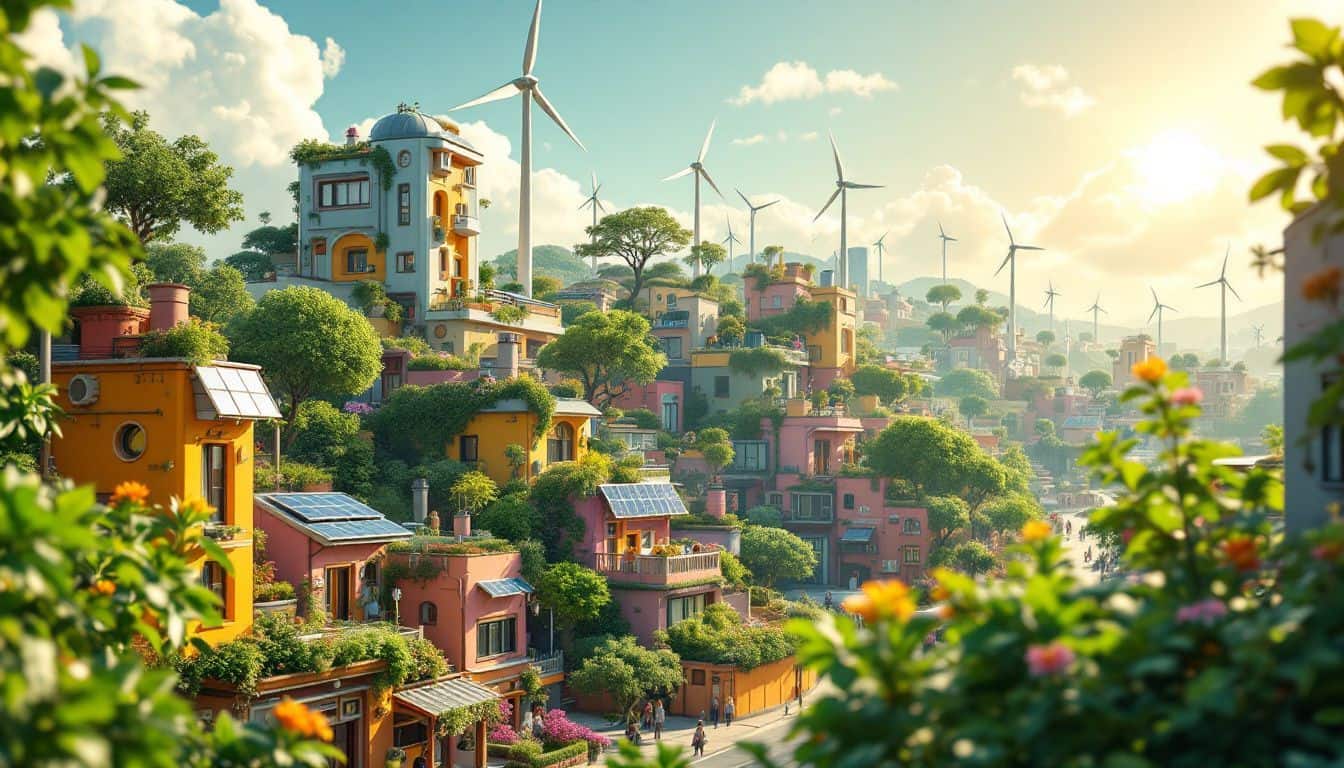 Solarpunk art bursts with life and hope. It mixes nature with tech in fresh ways. Think lush green cities with solar panels and wind turbines. Artists use bright colors and flowing lines inspired by Art Nouveau.
Solarpunk art bursts with life and hope. It mixes nature with tech in fresh ways. Think lush green cities with solar panels and wind turbines. Artists use bright colors and flowing lines inspired by Art Nouveau.
They draw from global styles, blending old and new. You’ll see plants growing on buildings and bikes zipping through tree-lined streets.
This art style isn’t just pretty – it’s a call to action. It shows a world where we’ve solved big problems like climate change. Olivia Louise’s 2014 Tumblr art helped kick off the look.
Now, you’ll find solarpunk ideas in books, games, and movies. It’s not all fantasy, though. Solarpunk art often includes real green tech and DIY projects. It’s a vision of a better future we can start building today.
The Environmental and Philosophical Vision of Solarpunk

Moving from the vibrant art of solarpunk, we dive into its green heart. This movement isn’t just pretty pictures. It’s a bold dream for a better world.
Solarpunk imagines a future where we live in harmony with nature. It’s all about clean energy, like solar power, and smart cities full of plants. Fans of this idea love self watering planters and rooftop gardens.
But it goes deeper. Solarpunk pushes for fair societies and local control. It fights big companies that hurt the planet. Instead, it backs green tech and DIY fixes. The goal? A world where everyone has enough, without wrecking Earth.
It’s a sunny view in a often gloomy world of climate fears.
Key Elements of Solarpunk
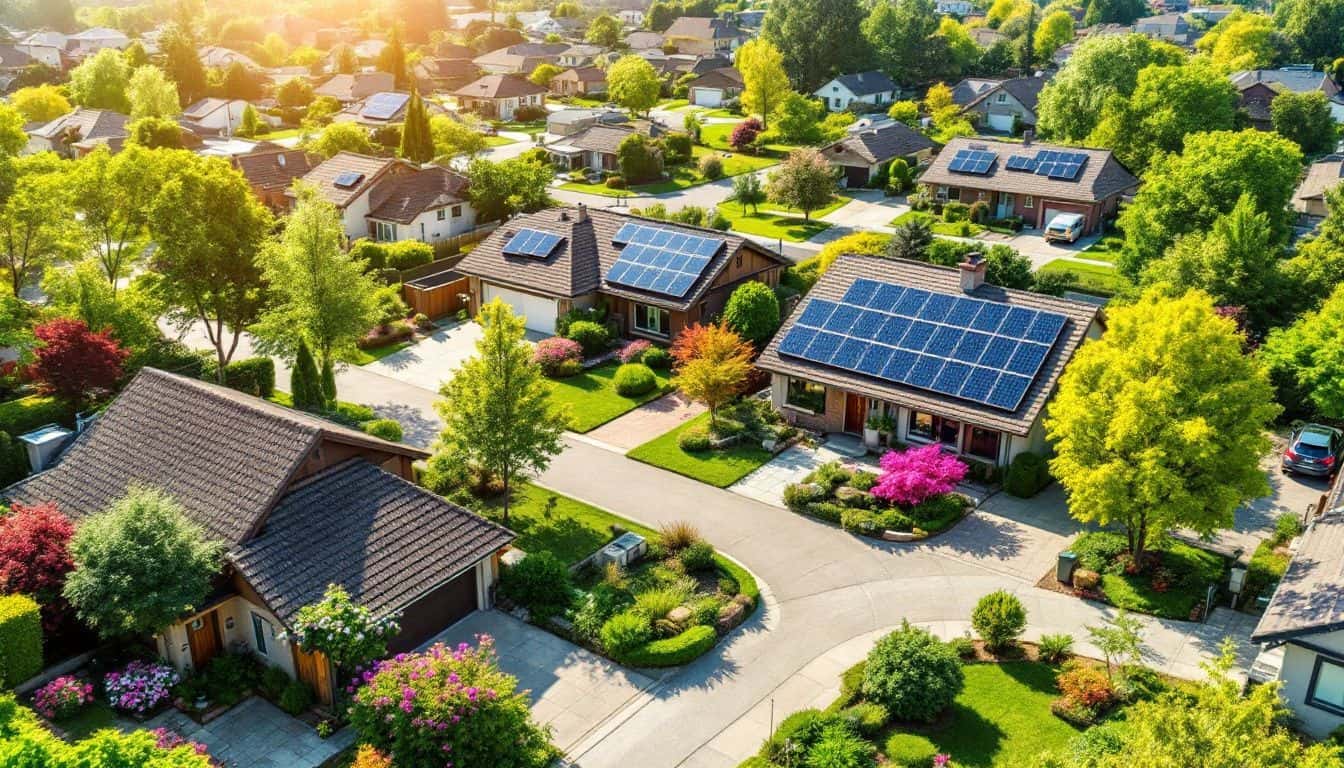
Solarpunk isn’t just about cool gadgets and green buildings. It’s a way of life that mixes eco-friendly tech with a can-do spirit. Picture solar panels on every roof and gardens in every spare space – that’s the solarpunk dream!
Integrating Renewable Energy in Solarpunk

Solarpunk dreams big on clean power. It’s all about ditching fossil fuels and embracing sun, wind, and water energy. Picture cities dotted with sleek solar panels and wind turbines.
But it’s not just about tech – it’s a whole new way of thinking. Solarpunk folks want energy that helps people, not just profits.
This green vision isn’t just make-believe. Real companies are already working on cool stuff. Verne Global is exploring new ways to use renewables. Climeworks is figuring out how to suck CO2 right out of the air.
Technology in solarpunk should prioritize people over profit.
And Carbon Upcycling Technologies? They’re turning that captured CO2 into concrete additives. Pretty neat, huh? Solarpunk isn’t just about individual gadgets – it’s about changing the whole system to work better for everyone.
Sustainable Technologies and the DIY Ethos in Solarpunk

Renewable energy is just the start. Solarpunk takes it further with a DIY spirit. Geeks, you’ll love this! It’s all about making cool stuff that helps the planet. Think solar-powered gadgets, home-built wind turbines, and even DIY water filters.
Solarpunk fans don’t just buy green tech. They make it! It’s like a maker faire meets Earth Day. People share plans online for free. They use recycled parts to build new things. It’s not just about saving money.
It’s about taking control of our future. This DIY approach fits right in with open-source ideals and fighting consumerism. It’s hands-on hope for a better world.
Rejecting Pessimism and Embracing Optimism in Solarpunk
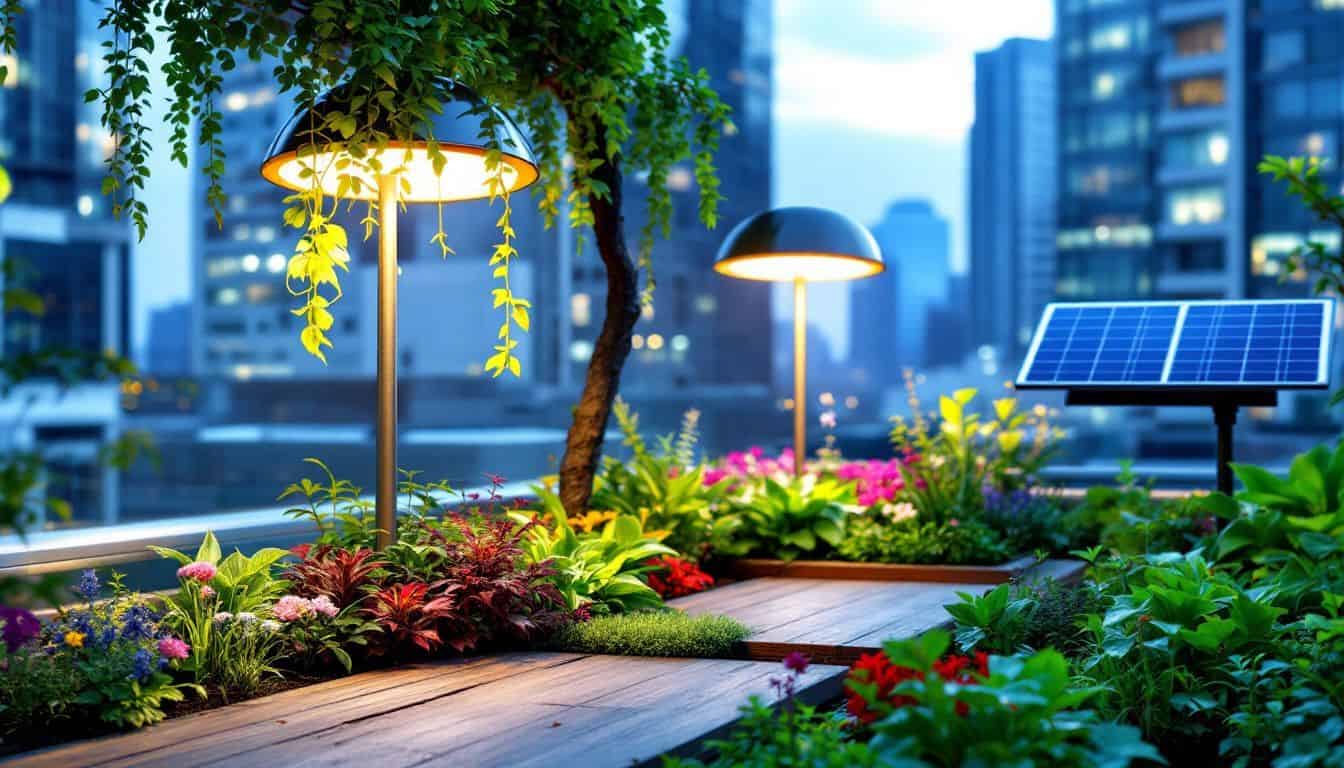
Solarpunk kicks doom and gloom to the curb. It’s all about bright futures and cool tech fixing our planet. No more moping around! This movement says we can beat climate change and make life awesome for everyone.
It’s like putting on rose-colored glasses, but they’re solar-powered.
I’ve seen this optimism firsthand at maker fairs. People show off wild inventions like algae-powered lamps and rooftop gardens. It’s infectious! You can’t help but feel hopeful when you see all these ideas come to life.
Next up, we’ll look at how solarpunk is shaking up books, movies, and games.
Solarpunk Representation in Media and Culture

Solarpunk isn’t just a cool idea – it’s all over books, movies, and games. From sci-fi novels to indie flicks, this bright vision of the future is catching on fast.
Solarpunk in Literature and Its Impact
 Solarpunk books paint bright futures where people and nature thrive together. They show worlds powered by clean energy, with lush cities and happy folks. These stories inspire readers to dream big and act now.
Solarpunk books paint bright futures where people and nature thrive together. They show worlds powered by clean energy, with lush cities and happy folks. These stories inspire readers to dream big and act now.
Ursula K. Le Guin’s “Always Coming Home” (1985) and Ernest Callenbach’s “Ecotopia” (1975) laid the groundwork for this genre. More recent works like Becky Chambers’ “A Psalm for the Wild-Built” (2021) keep the hope alive.
These tales do more than entertain. They spark real change. Readers often try to bring solarpunk ideas to life. They might start community gardens, push for bike lanes, or build solar panels.
The future is already here — it’s just not evenly distributed. – William Gibson
The stories show that a better world is possible. They give us tools to fight eco-anxiety and push for climate action. In short, solarpunk lit isn’t just fun – it’s fuel for a greener tomorrow.
Solarpunk Themes in Films
Films are bringing solarpunk ideas to life on the big screen. Hayao Miyazaki’s works, like “Nausicaä of the Valley of the Wind,” show lush green worlds where people and nature live in harmony.
“WALL-E” paints a picture of Earth’s rebirth after environmental disaster. James Cameron’s “Avatar” showcases a planet where aliens and their surroundings are deeply connected.
“Black Panther” stands out as a shining example of solarpunk ideals. The film mixes high-tech gadgets with natural beauty in Wakanda. It shows how progress can work hand-in-hand with tradition and respect for the environment.
These movies don’t just entertain – they spark hope for a greener future. Next, let’s look at how solarpunk is changing the game in tabletop RPGs.
Solarpunk’s Influence on Tabletop RPGs
From the silver screen to the gaming table, solarpunk’s reach extends far and wide. Tabletop RPGs have caught the solarpunk bug, and it’s spreading fast! Games like “Solarpunk 2050” and “Fully Automated!” let players dive into eco-friendly worlds.
These games aren’t just fun – they’re a peek into a brighter future.
In these RPGs, you’re not just rolling dice. You’re building green cities, harnessing solar power, and fixing society’s problems. It’s a far cry from the doom and gloom of cyberpunk games.
Instead, you get to be the hero who saves the planet! Players learn about sustainability while having a blast. It’s like sneaking veggies into a kid’s favorite meal – good for you, but still tasty!
Solarpunk Architecture and Urban Planning
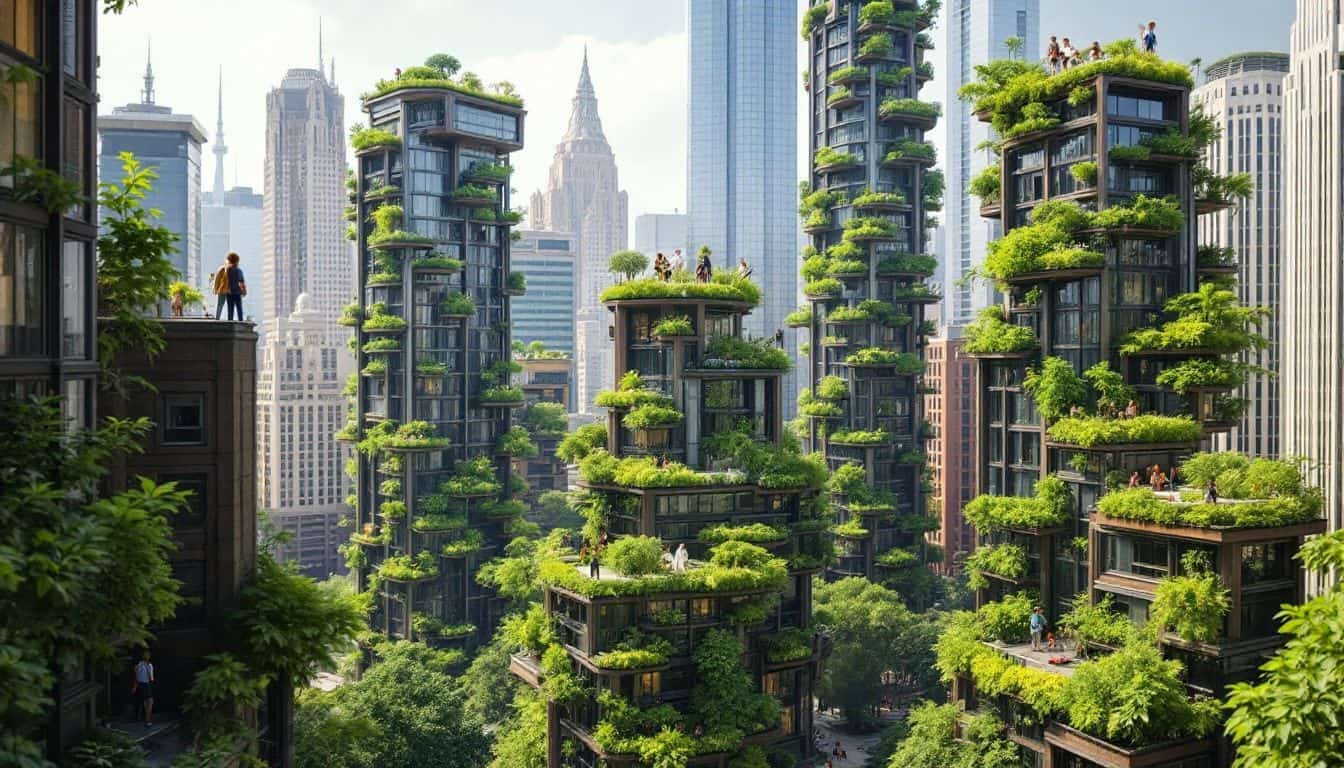
Solarpunk architecture blends nature with tech in cool ways. Picture green skyscrapers and rooftop gardens! Want to know more about these eco-friendly cities? Keep reading!
Characteristics of Solarpunk Architecture
Solarpunk buildings blend nature and tech in cool ways. They often have green roofs, living walls, and solar panels. Think of the Bosco Verticale in Milan – it’s like a vertical forest! These towers are covered in trees and plants, making them the world’s first oxygen-positive skyscrapers.
That’s pretty rad, right?
But it’s not just about looks. Solarpunk architecture focuses on using less energy and working with the environment. It might use natural cooling systems or collect rainwater. The goal is to create spaces that are good for people and the planet.
As one solarpunk architect put it:
We’re not just designing buildings, we’re growing ecosystems.
Urban Planning and Green Spaces in Solarpunk
Solarpunk cities buzz with green life. Parks and gardens pop up everywhere – on rooftops, walls, and even old parking lots. These spaces do more than look pretty. They clean the air, cool the city, and give people places to relax and play.
Urban planners blend nature with tech to create smart, eco-friendly neighborhoods. They use things like rainwater collection and solar panels to power these green areas.
Community gardens are a big deal in solarpunk towns. People grow food together, right in the city center. This helps fight food deserts and brings neighbors closer. Urban farms even show up on skyscrapers! The aim? To make cities that work with nature, not against it.
It’s all about building places where both humans and the environment can thrive side by side.
The Realism and Future of Solarpunk

Solarpunk isn’t just a dream – it’s happening now. Green roofs, solar panels, and urban farms are popping up everywhere. But there’s still work to do. Wanna see how we’re building a brighter future? Keep reading!
Addressing Practical Challenges in Solarpunk
Solarpunk dreams face real-world hurdles. Money is a big one. Clean energy tech costs a lot to set up. Folks in power often drag their feet on green policies. It’s tough to change old habits, too.
But solarpunks don’t give up. They get creative. They start small – like community gardens or bike-sharing programs. These projects show what’s possible.
Politics can be a roadblock. Big companies that profit from fossil fuels push back hard. They spend loads of cash to keep things as they are. Solarpunks need to be smart and work together.
They team up with local leaders and green businesses. They spread the word about clean energy wins. Step by step, they’re building a brighter future. It’s not easy, but it’s worth the fight.
Real-World Applications of Solarpunk
Practical challenges in solarpunk lead us to real-world examples. Some cities are already bringing solarpunk ideas to life. Take Milan’s Bosco Verticale, for instance. These “vertical forests” are apartment buildings covered in trees and plants.
They clean the air and provide homes for birds and insects.
Singapore’s Botanic Gardens show how green spaces can thrive in busy cities. Community gardens are popping up in many towns too. They help grow local food and bring neighbors together.
New tech like carbon capture is also helping us move to cleaner energy. Vertical farms are another cool idea. They can grow food right in the middle of cities, using less water and land.
These real-life projects prove that solarpunk isn’t just a dream – it’s starting to happen now.
Solarpunk Compared to Other Movements
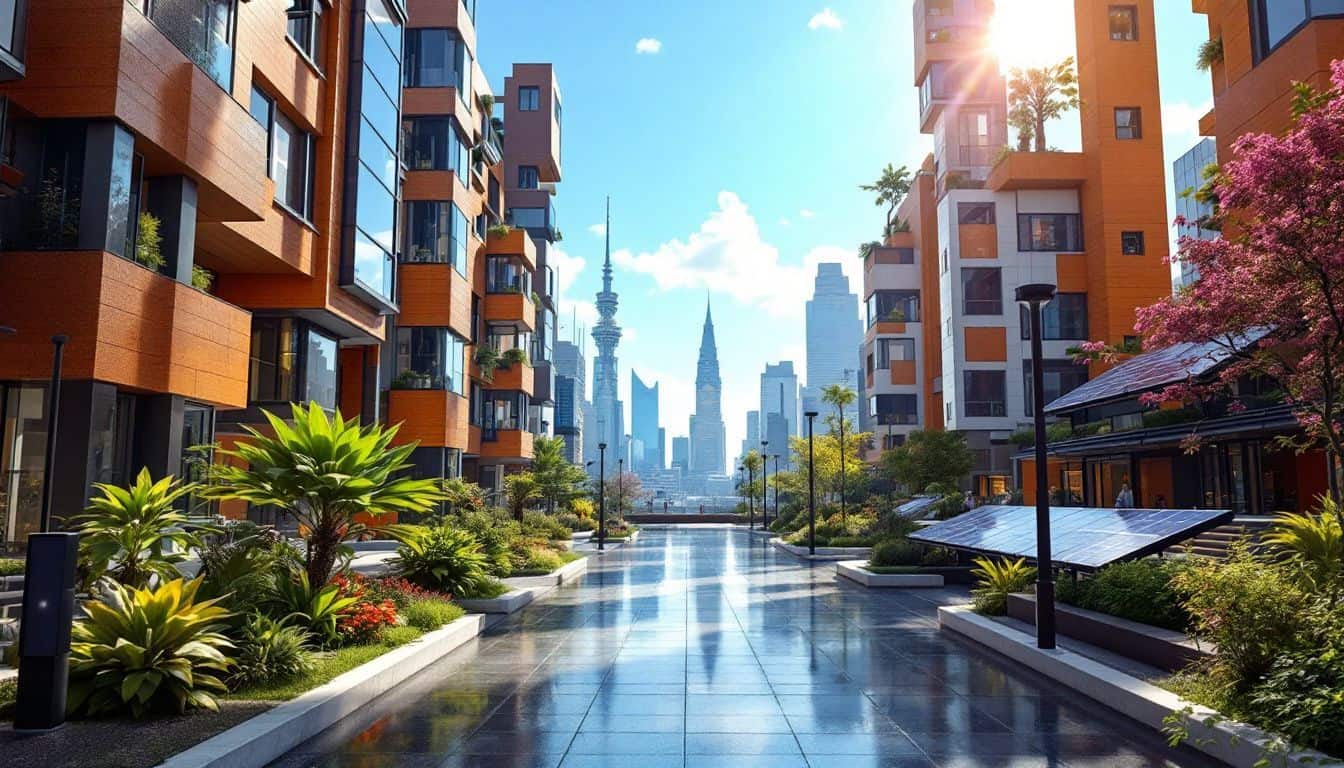
Solarpunk stands out from other sci-fi genres. It’s not all doom and gloom like cyberpunk or steampunk. Instead, it paints a bright future where we’ve solved big problems. Want to know how it stacks up against other -punk genres? Keep reading!
Contrasting Solarpunk with Cyberpunk and Ecopunk
Solarpunk, cyberpunk, and ecopunk – three sci-fi subgenres that paint very different pictures of our future. Let’s break down how these visions stack up against each other.
| Aspect | Solarpunk | Cyberpunk | Ecopunk |
|---|---|---|---|
| Outlook | Hopeful, optimistic | Dystopian, bleak | Cautiously optimistic |
| Aesthetics | Bright, natural, organic | Dark, neon, artificial | Green, earthy, rustic |
| Technology | Sustainable, renewable | Advanced, often oppressive | Eco-friendly, low-tech |
| Society | Harmonious, cooperative | Chaotic, individualistic | Community-focused, tribal |
| Environment | Thriving, integrated | Polluted, neglected | Recovering, protected |
| Power dynamics | Decentralized, democratic | Corporate-controlled | Localized, grassroots |
Cyberpunk often shows a world where tech rules supreme. It’s all about neon lights, hackers, and Corpo culture in Cyberpunk. But solarpunk? It’s the sunny side of sci-fi. Think green cities, clean energy, and people working together.
Ecopunk sits somewhere in the middle. It shares solarpunk’s green focus but with a grittier edge. Imagine post-apocalyptic communes trying to rebuild in harmony with nature.
I once visited an eco-village that felt like stepping into a solarpunk novel. Solar panels everywhere, communal gardens, and a real sense of community. It was a far cry from the dog-eat-dog world of cyberpunk stories.
In the end, these genres aren’t just about cool aesthetics. They’re about different ways of imagining our future. And right now? With climate change looming, that solarpunk vision is looking pretty good to me.
People Also Ask
What is Solarpunk, and how does it differ from other punk genres?
Solarpunk is a bright vision of the future. It’s not like cyberpunk or dieselpunk. Those often show dark worlds. Solarpunk dreams of a world powered by the sun. It’s about hope, not fear. Think green cities and happy people working together.
How does Solarpunk address climate change and environmental issues?
Solarpunk tackles big problems head-on. It imagines a world where we’ve beaten climate change. We use solar power and other clean energy. We grow food in vertical farms. We live in harmony with nature. It’s not just about tech, but also about how we treat the Earth and each other.
What role do indigenous peoples play in Solarpunk narratives?
Indigenous wisdom is key in Solarpunk stories. Take the Kalapuya or Klamath tribes. They lived in balance with nature for ages. Solarpunk learns from their ways. It respects their knowledge of the land. It imagines a future where all people, including those forcibly removed, have a voice.
How does Solarpunk approach economic systems and inequality?
Solarpunk doesn’t buy into the old ways. It dreams up new systems. Think circular economies and open-source tech. It’s not about making a few people rich. It’s about everyone having enough. It tackles inequality head-on. It imagines a world without the gaps between rich and poor.
What are some key technologies in Solarpunk visions?
Solar tech is the star, but there’s more. Concentrating solar power. Green design in buildings. Permaculture in farming. It’s about smart, kind tech. Tech that helps, not hurts. Tech that works with nature, not against it. And it’s not just new stuff. It’s also about using what we have better.
How does Solarpunk address social issues beyond environmental concerns?
Solarpunk isn’t just about saving trees. It’s about people, too. It tackles social injustices. It imagines a world without forced moves or unfair treatment. It dreams of cities where everyone belongs. Where no one is left out. It’s about building a society as healthy as the planet it lives on.
References
https://en.wikipedia.org/wiki/Solarpunk
https://builtin.com/articles/solarpunk
https://theanarchistlibrary.org/library/saint-andrew-what-is-solarpunk (2020-12-16)
https://www.bbc.com/news/business-57761297
https://www.yesmagazine.org/environment/2021/01/28/climate-change-sustainable-solarpunk (2021-01-28)
https://earth.org/solarpunk/ (2022-06-17)
https://www.resilience.org/stories/2022-12-20/solarpunk-radical-hope/ (2022-12-20)
https://www.academia.edu/87416944/PLANTING_SEEDS_OF_HOPE_A_SURVEY_OF_SOLARPUNK_FUTURES
https://architizer.com/blog/inspiration/stories/solarpunk-architecture-and-the-built-future/
https://www.debatemag.com/single-post/can-we-reach-a-solarpunk-future-in-t%C4%81maki-makaurau (2023-06-16)
https://fasterplease.substack.com/p/solarpunk-futurism-seems-optimistic

There is nothing less solar punk than filling your article with AI-generated images of exclusively white people.
Solarpunk is egalitarian, multiethnic, and aims to reduce environmental destruction. This piece does the exact opposite.
Except that, you know… the header image is exclusively featuring people of color.